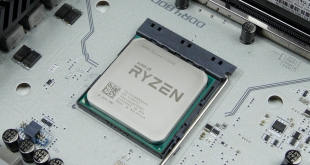
Ryzen 7 has already proven to be a worthy contender for Intel's LGA 2011-3 set of processors thanks to its similar, or sometimes better, performance levels and significantly cheaper cost. That metric is stretched even further with the 8C16T Ryzen 7 1700 that ships at just £330. At a relative bargain price compared to the higher-end Ryzen 7 SKUs, never mind Intel's £1000 octa-core part, Ryzen 7 1700 operates at a reduced clock speed out-of-the-box and is given a 65W TDP rating. You also get a decent Wraith Spire CPU cooler thrown into the bundle.
The most important point to enthusiasts is its retention of the unlocked CPU frequency multiplier that should allow a typical 1700 to reach 3.8-4.0GHz without much hassle. A £70-170 discount versus Ryzen 7 1700X and 1800X with the ability to hit similar top speeds certainly makes the 1700 chip an intriguing value proposition.
As we highlighted in our review of the 1700X, it is not uncommon for AMD to release multiple processor SKUs to market which are all essentially the same silicon. Binning is not an uncommon process in the computer hardware industry and it still remains an excellent method for enthusiasts to extract additional performance from a lower cost part.
For now, AMD's highest quality silicon forms the 1800X, with less-prime chips finding their home as 1700 and 1700X parts. There is a caveat to that logic, though, and that's the 1700's 65W TDP which will force it to use silicon that fits a different position on the voltage-frequency curve.
On the topic of that 65W TDP, we can already foresee the excitement of the 1700 to Small Form Factor (SFF) users once the AM4 mini-ITX motherboard situation improves. If you want to squeeze a high number of cores into a mini-ITX build, Ryzen 7 1700 looks to be an excellent method of doing so. That's also whilst avoiding the complexities of using LGA 2011-3 and 140W TDP Core i7 or Xeon CPUs in the same form factor. The ASRock X99E-ITX/ac is still an excellent work of engineering, nevertheless, which can single-handedly help Intel's HEDT platform in the SFF fight against Ryzen 7.
AMD's Ryzen 7 1700 comes bundled with a heatsink and fan, which is now unusual for £300+ CPUs since Intel removed the stock cooler from K SKUs with Skylake. The Wraith Spire cooler features a five-bladed, 92mm fan that forces air over an aluminium fin array fed by a copper slug in the core. The mounting mechanism now employs screws that fasten to an AM4 motherboard backplate, which is an upgrade over the relatively flimsy clip approach deployed with AMD's AM3 stock coolers.
Compared to an Intel stock cooler pulled from an old 4790K or modern multiplier-locked Core i5 or i7, it is easy to see the size advantage for the Wraith Spire. Also worth noting is the braided 4-pin fan cable that adds an element of quality. There's also an RGB LED ring on the top of the fan that can be controlled by the included 4-pin RGB adapter cable.
The Wraith Spire's mount on our AM4 ASUS Crosshair VI Hero was very solid and did not cause interference with neighbouring components. Removal of the plastic retention brackets is required as the cooler screws straight into the AM4 backplate. With the 4-pin RGB cable connected to our motherboard's header, the Wraith Spire cooler picked up the ASUS cyclic RGB profile without our adjustment and synchronised its operating mode and colours. Good job, AMD and ASUS.
Of course, being a cooler designed for use on AMD's PGA socket, you still get the old traditions of having to yank the CPU out of its socket when removing the cooler. This is largely due to the very sticky pre-applied thermal paste. It's something to watch out for if you decide to replace this cooler in the future as this is an easy way to damage the CPU.
| CPU | AMD Ryzen 7 1800X | AMD Ryzen 7 1700X | AMD Ryzen 7 1700 | Intel Core i7 6950X | Intel Core i7 6900K | Intel Core i7 6800K | Intel Core i7 7700K |
| CPU Codename | Zen | Zen | Zen | Broadwell-E | Broadwell-E | Broadwell-E | Kaby Lake |
| Core / Threads |
8 / 16 | 8 / 16 | 8 / 16 | 10 / 20 | 8 / 16 | 6 / 12 | 4 / 8 |
| Base Frequency | 3.6GHz | 3.4GHz | 3.0GHz | 3.0GHz | 3.2GHz | 3.4GHz | 4.2GHz |
| Boost Frequency | 4.0GHz | 3.8GHz | 3.7GHz | 3.5GHz | 3.7GHz | 3.6GHz | 4.5GHz |
| Maximum Frequency | 4.1GHz (XFR) | 3.9GHz (XFR) | 3.75GHz (XFR) | 4.0GHz (TBM 3.0) | 4.0GHz (TBM 3.0) | 3.8GHz (TBM 3.0) | n/a |
| Unlocked Core Multiplier | Yes (x0.25 granularity) | Yes (x0.25 granularity) | Yes (x0.25 granularity) | Yes (x1 granularity) | Yes (x1 granularity) | Yes (x1 granularity) | Yes (x1 granularity) |
| Total Cache | 16MB L3 + 4MB L2 | 16MB L3 + 4MB L2 | 16MB L3 + 4MB L2 | 25MB L3 + 2.5MB L2 | 20MB L3 + 2MB L2 | 15MB L3 + 1.5MB L2 | 8MB L3 + 1MB L2 |
| Max. Memory Channels |
2 (DDR4) | 2 (DDR4) | 2 (DDR4) | 4 (DDR4) | 4 (DDR4) | 4 (DDR4) | 2 (DDR4 & DDR3L) |
| Max. Memory Frequency |
1866 to 2667MHz | 1866 to 2667MHz | 1866 to 2667MHz | 2400MHz | 2400MHz | 2400MHz | 2400MHz / 1600MHz |
| PCIe Lanes | 16+4+4 | 16+4+4 | 16+4+4 | 40 | 40 | 28 | 16 |
| CPU Socket | AM4 | AM4 | AM4 | LGA 2011-3 | LGA 2011-3 | LGA 2011-3 | LGA 1151 |
| Manufacturing Process | 14nm | 14nm | 14nm | 14nm | 14nm | 14nm | 14nm |
| TDP | 95W | 95W | 65W | 140W | 140W | 140W | 91W |
| MSRP | $499 | $399 | $329 | $1723-1743 | $1089-1109 | $434-441 | $339-350 |
| UK Street Price | Approx. £500 | Approx. £400 | Approx. £330 | Approx. £1650 | Approx. £1000 | Approx. £400 | Approx. £330 |
Similarities between the entire Ryzen 7 line-up are vast. The 1700 retains the 8C16T design split over a pair of CPU Complexes (CCX) as is used for the 1700X and 1800X. 20MB of total cache is still available and the core frequency multiplier is unlocked to allow for easy overclocking.
The differences between the 1700 and other Ryzen 7 SKUs come in the form of out-of-the-box frequency, TDP, and XFR headroom. By default, the 1700 operates at a modest, due to the TDP target, 3.0GHz with a maximum Precision Boost clock speed of 3.7GHz. Highlighting the non-X difference of this SKU, XFR headroom is cut in half compared to the 1700X and 1800X, allowing the 1700 to operate at 50MHz above its maximum Precision Boost clock speed under the relevant conditions.
With sufficient cooling, you'll get a 3.2GHz all-core operating frequency out-of-the-box, 3.7GHz maximum multi-core Precision Boost operating speed, and 3.75GHz XFR frequency for single-core operations. Of course, that's before playing with the core ratio multiplier that can give 25MHz granularity for CPU speed increases.
For more information regarding Ryzen 7 and the AM4 platform, read our launch review for the Ryzen 7 1800X HERE. You can also read our Ryzen 7 1700X review HERE.
 KitGuru KitGuru.net – Tech News | Hardware News | Hardware Reviews | IOS | Mobile | Gaming | Graphics Cards
KitGuru KitGuru.net – Tech News | Hardware News | Hardware Reviews | IOS | Mobile | Gaming | Graphics Cards


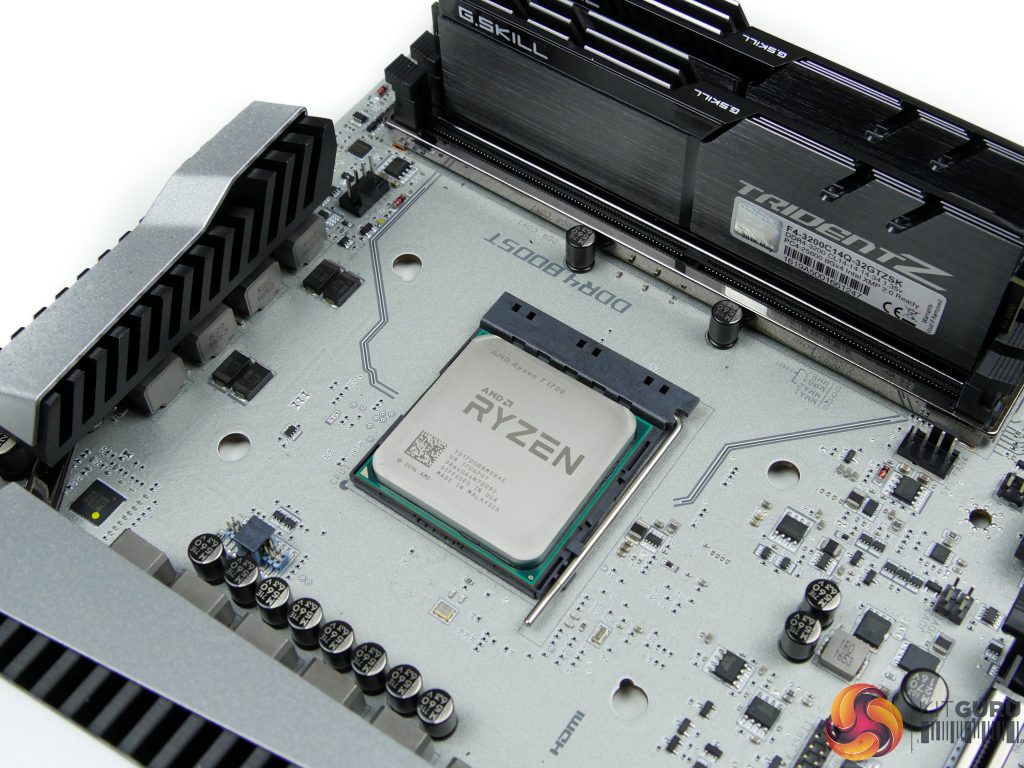

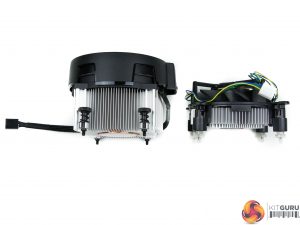
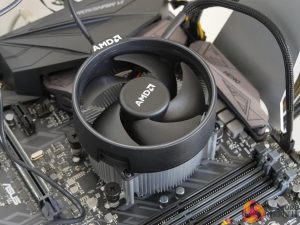
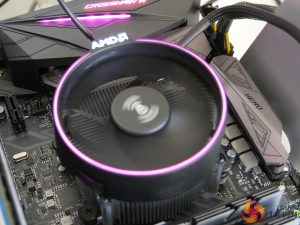
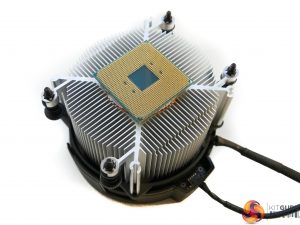
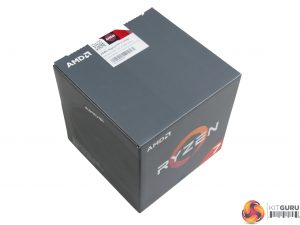

I was under the impression that XFR was only included on the X chips, yet you wrote that it is available on the 1700. Was this a mistake or is XFR actually enabled on the 1700 contrary to what I’ve read pretty much everywhere else?
XFR is enabled but only at half the headroom. The current X chips get 100MHz of XFR headroom whereas this non-X chip gets 50MHz. We validated this with multiple single-threaded tests and watched the frequency in CPUID HWMonitor report as 3750MHz on the loaded cores.
Interesting. I didn’t know that was a thing. Thanks!
Next gripe. Page 3 has the Ryzens listed at Summit Ridge, which isn’t their code name. The code name was Zen. Summit Ridge refers to the Zen based APUs that AMD has yet to release.
Thanks for the info. I’ve been following closely but I was completely unaware that the 1700 had XFR.
Good review, so in summary, if you want to play your games at very low resolutions, with refresh rates that your monitor does not support get the i7-7700k . But if you want a real PC that can do all other workstation tasks, and game at high resolution, get the Ryzen 1700. Anyhow, I don’t think anymore will buy a high end GPU and play in low res. What we need is a Real World comparison between the AMD and Intel chips. Can you do one for us please?
The 1700 is an impressive cpu. I can’t deny that it will do better in games once developers begin optimizing. I have mine sitting in the MSI Carbon Pro and is happily running at 4.0ghz 24/7 at 1.3875vcore. However try as I might I am not able to get my 3200 ram above 3000 at the moment. MSI have not been quick to produce new bios revisions and to date only have the one bios listed on their website!!!
There are 4K gaming tests in there also, which show very little difference between the Intel and AMD chips due to such demand being placed on the GPU. As for high refresh rate gaming, almost half of our readers like to game at 100 FPS or above: http://www.kitguru.net/tech-news/featured-announcement/matthew-wilson/kitguru-poll-shows-49-3-percent-of-readers-prefer-gaming-at-100hz-and-above/
This review is done so well except you don’t even have a 6900k!
wow I hate the smooth scrolling on your website, it’s the worst thing ever invented.
What your readers say and what they do is very different. Not that many people actually have >60hz monitors.
So my 1700 hits 3.75Ghz on all cores at 1.225v, is that a good result? I’ve only ever overclocked on intel’s x79 and x99 platform so I’m a bit clueless when it comes to AMD. Rock solid stable for 5 hours, even on the stock cooler didn’t see temps over 70C.
Any help haha?
I agree that monitors with refresh rates higher than 60Hz are less common. But we cannot ignore the fact that almost half of our readers are also interested in performance relating to higher refresh-rate gaming.
Either way, 1080P and 4K data are both in the review. If a reader is not interested in high refresh rate gaming, then checking that the CPU of interest can handle 60 FPS in the relevant game should be a sufficient interpretation of the results.
I would say that is a pretty good overclock. You could probably push the frequency around 150-250MHz higher but that will require a voltage increase and better cooler. The power draw and temperatures at 1.225V should be fine for long-term use. If that’s stable enough for your needs, I’d be inclined to stick with that balance of frequency and voltage, personally. But if you need more performance you may be able to push frequency a little higher with increased voltage.
I honestly can’t believe anyone would like to game at 100 FPS or above at Ultra Low Quality. Its like saying, that your readers also prefer to watch a block buster movie on their smart phones, instead of going to the cinemas. Anyhow, as you have mentioned there is no difference in gaming in the real world, the Ryzen wins easily when it comes to all other workstation use. The choice here is a no brainier.
That’s subjective. Each to their own preference. High refresh rate gaming doesn’t have to be low quality (resolution) either – there are 2560×1440 and 3440×1440 100Hz+ monitors on the market and 100Hz+ 4K monitors coming out this year. There are people using high refresh rate monitors so we can’t just ignore that fact. If it isn’t of importance to your usage scenarios, the performance on offer may be ideal for you.
I`m very curious what motherboard are you using to achieve that OC?
From what you are saying, I honestly can’t fandom why anyone would buy a 4K monitor with high refresh rate, then downscale it to 1080p, and buy high end gaming PC hardware just to play at high FPS at 1080p. Like I said, we need to focus on the real world tests here, not some unrealistic scenario. In the real world, people do more with their CPU than just gaming, many people multi-task while gaming. It would be very beneficial to do a multi-tasking gaming benchmark to see if the extra cores of Ryzen are really useful in the real world or not. A typical example would be streaming and gaming, do the extra cores help make Ryzen a better real world gaming PC?
But aren’t high refresh rates the domain of the GPU? How does a CPU affect refresh rates?
Check this out, there’s a YouTube Channel called “Game Testing” that pits different CPUs against each other and also different GPUs against each other and shows them in split-screen mode in real-time. On the left side of the screen you have one contender and on the right side you have the other contender both running at the same time.
I think that these are really creatively done (and I didn’t do them) and they really do show the difference (especially the lack thereof) in gaming between the Summit Ridge (R7-1700) and Kaby Lake (i5-7600K) architectures. Both CPUs are at stock clocks, the resolution is demonstrated to be 1080p and an nVidia GeForce GTX 1070 to ensure that there are no GPU bottlenecks. Enjoy!
We’ll start with a video that pits the R7-1700 against the i5-7600K in seven modern titles. Those titles are Project Cars, Arma III Apex, Fallout 4, Rise of the Tomb Raider, Hitman 2016, Just Cause 3 and Far Cry Primal.
https://www.youtube.com/watch?v=RBbJtOPUVcU
Now to add more like Grand Theft Auto V:
https://www.youtube.com/watch?v=UFffMS6m2vg
The Witcher 3:
https://www.youtube.com/watch?v=TXOHmZEQmAc
Crysis 3:
https://www.youtube.com/watch?v=piNUGg3pejA
Need For Speed 2015:
https://www.youtube.com/watch?v=y57Beci-vf0
Far Cry 4:
https://www.youtube.com/watch?v=jJ4Mi62bvkA
Watchdogs 2:
https://www.youtube.com/watch?v=rNq2hPMrmTw
And Battlefield 4:
https://www.youtube.com/watch?v=vgLNFpgFOl4&t=48s
So there’s fourteen games, all played at 1080p with a GTX 1070 with one side of the screen using an R7-1700 and the other side using an i5-7600K. I hope that this helps give a real and meaningful demonstration, far better than any benchmark bars ever could. I didn’t make these videos but they are the best thing I’ve ever seen for demonstrating real gameplay experience between Summit Ridge and Kaby Lake. Their channel has a whole bunch of other videos including videos saying that I don’t even need to upgrade my old FX-8350 for gaming just yet!
How do you like those benchmarks now? LOL
The CPU needs to prepare the data for the GPU. The faster the GPU requests that data, the faster the CPU needs to prepare it. That’s why high refresh rate gaming puts additional onus on CPU performance whereas 60 FPS gaming is generally comfortable for modern CPUs of this calibre (if the GPU is sufficiently fast).
That’s great, thanks for the benchmarks, as you said it gives a true picture of what is going on, much better than any graphs. So there is no real world difference between the game plays, i can’t tell the difference between 200 and 210 fps lol.
when i removed my cpu some accidental thermal paste went inside the pins. is it okay?
It’s not conductive but could cause a problem later making the joint between the pins capacitive in nature later on down the road as it dries somewhat. That’s a problem don’t risk it.
Make sure when you do this below that the alcohol level IS NOT higher then just to soak pins
and barely contacting the base. You don’t throw it in and submerge it. Use some common sense here.
And it will be fine.
So:
• Take a disposable bowl.
• Take 90% or higher isopropyl alcohol.
• Pour about one cup of alcohol into the bowl.
• Place chip pin side down into bowl.
• Let soak for about 5 – 10 minutes.
• Wait.
• Order a Pizza.
• Take a toothbrush, preferably a soft bristled one and dip that into the alcohol also.
• Softly and I mean softly brush in between the pins till all the thermal grease is removed.
• Let CPU dry on either a lintless towel or a paper towel till the alcohol is evaporated.
• Drink the remaining alcohol. Both in the bowl and in the bottle. It’ll put hair on your chest.
• Throw the bowl away. In a recycling bin. Good for the planet.
• Eat Pizza, remembering to wash your hands before returning to work.
• Replace CPU in socket, then reapply AS5.
ty
You can really see how the ryzen 7 line up is binned. 1800x better idle than 1700x -> better than 1700.
Intel: Anti-Competitive, Anti-Consumer, Anti-Technology.
https://www.youtube.com/watch?v=osSMJRyxG0k